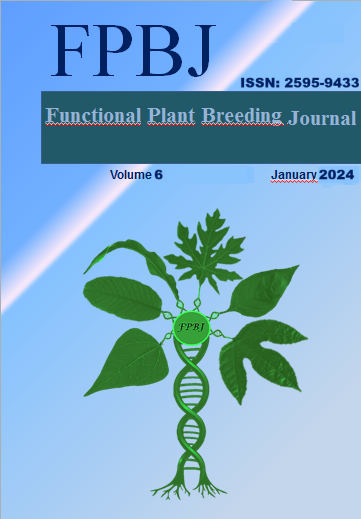Comparison of grain yield and identification of QTLs of rice populations derived from the Bulk and SSD (Single Seed Descent) methods
Abstract
Bulk and SSD are widely used methods for developing segregating populations in plant genetic improvement programs. This work aimed to analyze grain yield (GY) QTLs using two populations from the Epagri 108 × Irat 122 cross, advanced by the SSD (F8 generation) and Bulk (F7:8 generation) methods. The 158 recombinant inbred lines (RILs) of each method (SSD and Bulk) were evaluated for two years (2017 and 2018 crop seasons), in an 18x18 lattice square experimental design with two replications. The RILs were genotyped using the DArTseq® methodology, which generated around 6 thousand SNPs and SilicoDArTs. The statistical model adopted for the analysis of GY data was a mixed linear model (MLM). For the first and second year evaluations and joint analysis, the RILs-Bulk group presented higher productivity averages when compared to the group RILs-SSD and Checks. However, in relation to the genetic variance component, the SSD group presented the highest estimate followed by Bulk and Checks. The GY of the RILs-Bulk ranged from 4,010.75 kg.ha-1 to 5,815.42 kg.ha-1, while the RILs-SSD ranged from 3,321.76 kg.ha-1 to 8,096.27 kg.ha-1, both exceeding the Check group, which ranged from 2,754.30 kg.ha-1 to 3,643.73 kg.ha-1. For QTL analysis, multiple interval mapping was applied, with 2,115 SNPs genotyped in the RILs-SSD, resulting in three QTLs identified (qGYLD6, qGYLD6.2 and qGYLD9). For RILs-Bulk, with 2,354 markers, three QTLs were identified (qGYLD6 and qGYLD9), and in the joint analysis, one QTL was mapped (qGYLD7). The next step will be to validate the markers identified by genotyping accessions from the Germplasm bank before being used in assisted selection for the GY trait. Both the SSD and Bulk methods were efficient in obtaining high grain yield RILs and in the ability to identify QTLs. However, the Bulk method was more practical to handle and cheaper to obtain RILs compared to SSD.














